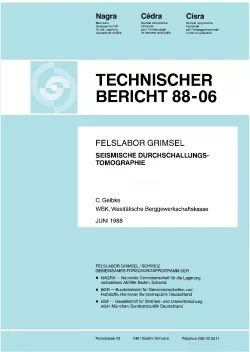
Technischer Bericht NTB 88-06
Felslabor GrimselSeismische Durchschallungstomographie
During the period of July to October 1985 the Institute of Geophysics of the Westfälische Berggewerkschaftskasse (WBKIGL) conducted a seismic field experiment at Grimsel Test Site in Switzerland. The areas of investigation are located between the laboratory tunnel and the subhorizontal 150 m long boreholes BOUS 85.001, BOUS 85.002 and BOUS 85.003 (field 1 – 3) and between the laboratory tunnel and the surface on the Juchlistock (field 4).
Travel times and amplitude data from the direct p-waves were used to calculate tomograms of the site, which contain the 2-dimensional distribution of seismic velocity respectively attenuation.
Tomograms of velocities can be used to distinguish between fractured and intact rock masses. Initially, part of the disturbed zones (i.e. areas of induced fracturing) were already known from geological characterization studies.
Velocity profiles calculated from sonic borehole measurements agree extremely well with velocities determined from tomograms in the vicinity of the boreholes. The average discrepancy between the two independent data sets is 1 %, which corroborates the reliability of tomographic inversion.
According to an anisotropic velocity distribution of the rock with maximum velocities in NE-SW direction (50° ± 5°), a correction had to be applied to data prior to inversion. The magnitude of this anisotropy, which was also demonstrated in core samples in the laboratory (Berkhemer 1987), is approximately ± 1 %.
Tomograms calculated for attenuation still show the effects of systematic errors (technical problems). Only very pronounced fracture zones can be detected from these tomograms.
The following report includes the technical documentation of the experiment and the numerical inversion of the data. A more detailed presentation of the layout, completion and rating of the experiment as well as the field preparation will be given in a separate report.
